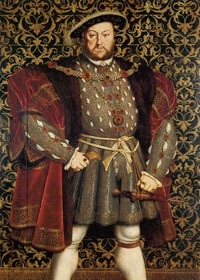
The King’s Great Matter As a boy of eighteen, Henry VIII married the Spanish princess Catherine, the widow of his elder brother. It was a 「Marriage of State,」 arranged to establish a political alliance with Spain and was quite in line with the traditions of royal marriages in most countries. These were not looked upon as private matters, but instead were to be decided according to national interests. Today there is no legal or moral objection to a man marrying his brother’s widow, but in Henry’s time such a marriage was held by the Church to be within the circle of forbidden relationships: in Henry’s case the marriage was allowed by Papal dispensation – it was nothing extraordinary, for exceptions to rules could always be managed for reasons of state.
In ten years time, seven children were born to Henry and Catherine, but six of them died in infancy: the one daughter who survived, Mary Tudor, was later to be known as 「Bloody Mary.」 Like most kings, however, Henry desired a son to inherit his throne, and believed he might have a son with another wife – one not of forbidden status. He therefore he applied to the Pope for an annulment of his marriage to Catherine.
Henry had reason to believe that his request would be approved, for special dispensations or annulments of marriages were commonly obtained with no great difficulty by persons of wealth or rank. Lawyers in Rome often gained considerable revenues by obtaining marriage annulments for people who could afford them, and Henry was asking only for something that other kings had easily obtained. A few years earlier, Louis XII of France secured an annulment of his marriage to Jeanne de Valois on very simiar grounds. The king no doubt thought he would have very little difficulty in getting the desired annulment, but international politics would prevent this from happening.
Henry’s wife was not only a princess of Aragon, but also the aunt of Charles V, who was both King of Spain and Holy Roman Emperor. In addition to being the most powerful man in Europe, Charles was at that time, in temporal control of Rome, his troops having sacked the city in 1527. The Pope, Clement VII, could not afford to offend Charles by removing his aunt from her royal position. At the same time he did not wish to disturb his relations with Henry, so the matter was left largely unsettled for several years. In 1534 Clement VII died and was succeeded by Paul III, who eventually prepared a bull of excommunication against the English King.
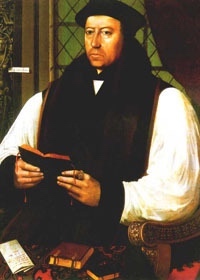
Pope Paul’s action was not unexpected, since Henry, not willing to wait for the political situation to change, had in 1533 put away Catherine and married Anne Boleyn. In doing so, however, he had taken a number of steps to try and buttress the legitimacy of his case. He had asked for and received from English and continental universities a number of opinions favorable to an annulment of his marriage. He had also received from Archbishop Thomas Cranmer, whose elevation to the See of Canterbury had been approved by the Pope, a judgment that his marriage to Catherine was contrary to the law of God and that the new marriage was valid. All of this was done within the framework of contemporary legal and sacramental views on marriage.
It was also largely political, and had circumstances in Rome been different, it is likely that the 「king’s great matter」 would be another footnote in the history of the medieval Church. But Henry’s divorce happened to coincide with rise of Lutheranism among the princes of northern Germany, and in their actions he saw a means of freeing himself from the influence of the Pope. In 1530, Henry demanded, and received from a convocation of the English Church, recognition as its supreme head, with the stipulation 「insofar as the law of Christ will allow」. Soon came a resolution that 「the bishop of Rome hath by scripture no greater authority in England than any other foreign bishop.」 Such a denial was not merely the contradiction of an individual Pope–it was instead a repudiation of claims to universal authority by the Roman See. Whatever one might think of Henry’s motives, the break with Rome restored to the English Church a level of autonomy not seen since the days of the Conqueror.
Throughout the 1530s the Church of England continued its religious customs and manners much the same as before. It retained all of its bishops, save one, and kept its orders of priests and deacons intact. Its ministry and sacraments were not altered in any essential manner. In fact, in 1539, Henry issued the Statute of Six Articles which confirmed the catholic nature of the Church of England. People went to the same churches and heard the Mass in Latin from the same priests as before. The nature of Christ’s presence in the Eucharist was still defined in the same way it had been in before. Priests who in the past had taken vows of celibacy were still forbidden to marry. As in the Eastern Orthodox Church, which had broken off its ties with Rome in 1054, the Church of England did nothing to violate its original character of continuity.
The Regency Council In 1547, after a reign of thirty-eight years, and fourteen of separation from Rome, Henry VIII died. The crown passed to his son Edward VI, a boy of nine whose mother was Henry’s third wife, Jane Seymour. During the short reign of the boy king, the country was actually controlled by a Regency Council, which was in turn controlled by unscrupulous noblemen who took up radical Protestantism for their own personal advantage. The head of the council was the King’s uncle, the Duke of Somerset, who was made Lord Protector. Under his leadership members of the council took possession of churches, universities, schools, and other institutions. A great deal of religious property was destroyed and buildings were wrecked in order to take the material. Somerset would even have razed Westminster Abbey to build a palace for himself, had he not been bought off with gifts of properties.
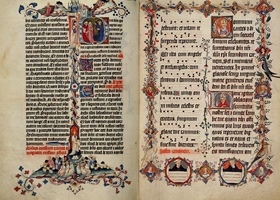
In the midst of this turmoil, a new liturgy was adopted, that of the Book of Common Prayer. This was an English translation of the Latin Breviary (the prayers, psalms, and readings for the canonical hours), Missal (the rites and ceremonies of the Mass) and Pontifical (episcopal sacraments and rites). There was some revision involved, but the Prayer Book exhibited a continuity with its sources in essential matters. This new book was in no way a disavowal of the Catholic faith; rather it was designed to put prayer in the hands of the people. The Prayer Book was introduced in 1549 and generally accepted without incident, but a rebellion did arise in the area of Devon and Cornwall, a strongly traditional region of the country. Though the new Prayer Book may have been the spark that set the rebellion alight, its origins lay with Somerset’s governance in general. Though the rebellion was eventually put down, in October of 1549, Somerset was arrested and sent to the Tower. Though he was freed shortly thereafter, he was executed in 1552 for plotting against the regime.
Somerset was succeeded as Lord Protector by The Duke of Northumberland, who continued the policies of his predecessor. The Regency Council assumed authority over the bishops, and treated them like state officials, subject to the will of the Council: three bishops who resisted the authority of the Council were imprisoned, and two others were deprived of their office. The English Church was forced to accept radical reformers from the Continent, to whom were given important posts in the Church. Likewise the Book of Common Prayer was again revised and a set of Protestantizing Articles were promulgated by the Crown. These 「Forty-Two Articles」 were never part of the Prayer Book itself and are unlikely to have been authorized by Convocation. They did, however, serve as the basis for the 「Thirty Nine Articles」 which were adopted by the Elizabethan Church in 1571.
The Marian Reaction
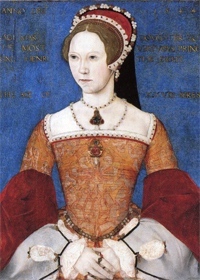
A few months after the second Prayer Book was issued, Edward VI died. Northumberland made an effort to stay in power by attempting to put Lady Jane Grey, his daughter-in-law, on the throne. Lady Jane was a Protestant and and a cousin of Edward VI, but Northumberland’s plan was thwarted when the Regency Council proclaimed Mary Tudor, the only surviving child of Henry VIII and Catherine of Aragon, to be queen. Northumberland was executed for treason and the country received Mary with great enthusiasm. It was hoped that her reign would bring a period of religious toleration, but unhappily, this did not occur.
Soon after Mary became queen, she made arrangements to restore relations with the Papacy. Parliament repealed anti-papal laws, and bishops who had been imprisoned in the previous reign were set free. A number of the bishops and a great many of the priests continued to hold their positions, but some were removed on account of having married. Others were imprisoned, and still others fled to Switzerland and Germany. For having given support to the cause of Lady Jane Grey, Archbishop Cranmer and others were charged with treason, and burned at the stake. Meanwhile Cardinal Reginald Pole, an Englishman who had been living in Rome, returned to England as papal legate and was made Archbishop of Canterbury.
From time to time Mary, understandably, filled sees with sympathetic bishops, but she went beyond that and sought to make examples of those who opposed her in religious matters. Many people were charged with heresy, and no small number of them died in prison; others were burned at the stake. Among those executed were five bishops, more than twenty priests, eight noblemen, eighty-four tradesmen, more than a hundred laborers and servants, and fifty-five women and children. From this, she earned the sobrioquet, 「Bloody Mary.」 After five years, however, Mary died, and her half-sister, Elizabeth, the daughter of Henry VIII and Anne Boleyn, came to the throne.
The Age of Elizabeth Queen Elizabeth had been declared illegitimate by Rome, and English papists were disputing her right to rule. As a result, she soon took steps to remove those whose loyalty she could not trust. Bishops of Mary’s time who refused to acknowledge Elizabeth’s authority were put out of office, while others, who had been removed in Mary’s time, were restored to their former dioceses. In 1559 the Book of Common Prayer was revised again and ordered to be used at all services. In Mary’s time all prayer books in English that could be found in churches were destroyed, but when Elizabeth went from Latin back to English, few people objected.
There were three factions in the Church in Elizabeth’s time, each struggling to gain the upper hand: the Romanists, the Puritans, and the Churchmen. The Romanists wanted the Church to continue as in Mary Tudor’s time, subject to Rome. The Puritans leaned so far in the opposite direction that they wished to cut all connections with the historical Church of England, and to form a new Church along entirely Protestant lines. The Churchmen hoped to steer a middle course. They were determined to preserve the doctrine and sacraments that they had known from the beginning, but at the same time, they were equally determined to keep the English Church free of any bondage to Rome. Elizabeth stated the position of the Churchmen of her time when she said, 「there has been no new faith propagated in England, no religion set up but that which was commanded by our Saviour, preached by the primitive Church, and unanimously approved by the Fathers of best antiquity.」
Between 1558, when Elizabeth became queen, and 1570, there were three popes who did nothing to disturb the Church of England, and in fact during that time there were repeated efforts to bring about a reconciliation. It was, for example, proposed that the Church of England might keep its liturgy in English instead of Latin, if Elizabeth would recognize it as a privilege granted by papal authority. Though such a compromise may have been agreeable to many of her subjects, it was unacceptable to Elizabeth, as it infringed upon her prerogatives as the English sovereign. After this and other efforts toward reconciliation failed, Pope Pius V issued his famous bull of excommunication, in which he declared Elizabeth to be deprived of her right to the throne of England, and released all her subjects from their allegiance to her. He furthermore declared her to be cut off from Christ, and ordered the faithful to withdraw from the Church of England.
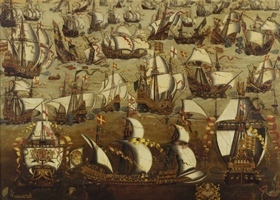
Despite their lack of temporal authority, the Popes of the era intended to make the decree against Elizabeth effective and relied upon France and Spain to enforce it. Missionaries came from Douai to encourage Romanists, and various plots that were formed led to the implementation of severe penalties against those who were seen as enemies of the state. In 1588 matters came to a head as the Spanish Armada was sent to destroy the English Navy and so prepare the way for a land invasion. Famously, the Armada met with a crushing defeat, and England was spared. Elizabeth’s continuance on the throne until her death in 1603, resulted in a period relative stability for the Church and allowed the policies now known as the 「Elizabethan Settlement」 to take hold.
What emerged out of the turmoil of the sixteenth century was a Church that had been jolted out of the Middle Ages by an unlikely combination of base politics and new ideas from the Continent about religious reform. Yet despite the influence of Luther and later Calvin, the Church still retained its essential character–its catholic sacraments and ministry. This would be tested in the years ahead, but never abandoned. The Church of England would retain its identity as both catholic and reformed.